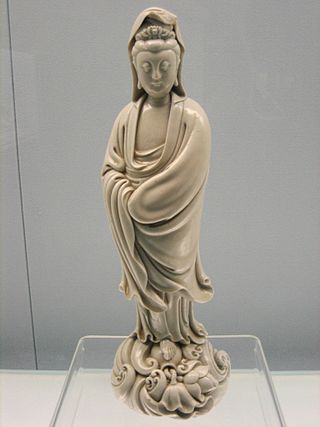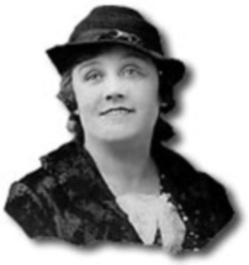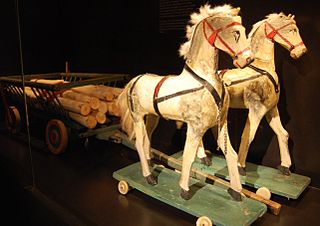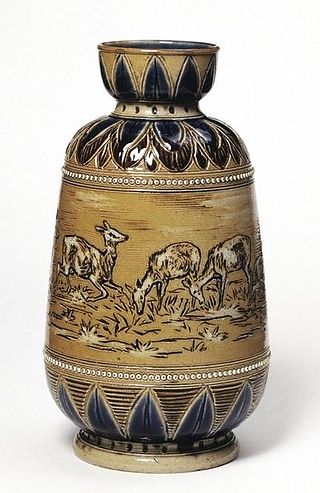Related Research Articles

A figurine or statuette, is a small, three-dimensional sculpture that represents a human, deity or animal, or, in practice, a pair or small group of them. Figurines have been made in many media, with clay, metal, wood, glass, and today plastic or resin the most significant. Ceramic figurines not made of porcelain are called terracottas in historical contexts.

Clarice Cliff was an English ceramic artist and designer. Active from 1922 to 1963, Cliff became the head of the factory creative department.
North Dakota in the United States has been the scene of modern era pottery production using North Dakota clays since the early 1900s. In 1892 a study was published by Earle Babcock, a chemistry instructor at the University of North Dakota (UND) that reported on the superior qualities of some of the North Dakota clays for pottery production. The UND School of Mines began operations in 1898 with Earle Babcock as director. With the assistance of several eastern potteries, pottery made from North Dakota clay was first displayed at the 1904 St. Louis World's Fair.

Model horses are scale replicas of real horses. They originated simultaneously – but independently – in the United States, Canada, and the United Kingdom, followed later by Sweden (UK-influenced), Germany (US-influenced), and Australia. They encompass a wide variety of fanbase activities, from those who simply like to collect, to those who show their models at model horse shows. Unlike model cars or trains, model horse collectibles do not need to be assembled from kits, although they can be altered to the collector's liking.

Royal Doulton is an English ceramic and home accessories manufacturer that was founded in 1815. Operating originally in Vauxhall, London, and later moving to Lambeth, in 1882 it opened a factory in Burslem, Stoke-on-Trent, in the centre of English pottery. From the start, the backbone of the business was a wide range of utilitarian wares, mostly stonewares, including storage jars, tankards and the like, and later extending to drain pipes, lavatories, water filters, electrical porcelain and other technical ceramics. From 1853 to 1901, its wares were marked Doulton & Co., then from 1901, when a royal warrant was given, Royal Doulton.

Metlox Pottery, strictly speaking Metlox Manufacturing Company, was a manufacturer of ceramic housewares, located at 1200 Morningside Drive, Manhattan Beach, California, US. The pottery factory closed in 1989.

Wade Ceramics Ltd was a manufacturer of porcelain and earthenware, headquartered in Stoke-on-Trent, England. Its products include animal figures for its Collectors Club, whisky flagons, and a variety of industrial ceramics.

Royal Copenhagen, officially the Royal Porcelain Factory, is a Danish manufacturer of porcelain products and was founded in Copenhagen in 1775 under the protection of Danish Dowager Queen Juliane Marie. It is recognized by its factory mark, the three wavy lines above each other, symbolizing Denmark's three straits: Storebælt, Lillebælt and Øresund.
The Fiesta Tableware Company is a ceramics manufacturer located in Newell, West Virginia, United States. Established in 1871, it is widely known for its Art Deco glazed dinnerware line, Fiesta. In 2002, The New York Times called Fiesta "the most collected brand of china in the United States".
John Beswick Ltd, formerly J. W. Beswick, was a pottery manufacturer, founded in 1894 by James Wright Beswick and his sons John and Gilbert in Longton, Stoke-on-Trent. In 1969, the business was sold to Doulton & Co. Ltd. The factory closed in 2002 and the brand John Beswick was sold in 2004. The pottery was chiefly known for producing high-quality porcelain figurines such as farm animals and Beatrix Potter characters and have become highly sought in the collectables market. Pronunciation of Beswick is as at reads, Bes-wick. This information was from employees who worked at the original Beswick factory.

Bing & Grøndahl was a Danish porcelain manufacturer founded in 1853 by the sculptor Frederik Vilhelm Grøndahl and merchant brothers Meyer Hermann Bing and Jacob Herman Bing. The trademark backstamp for Bing & Grøndahl (B&G) porcelains is the three towers derived from the Coat of Arms of Copenhagen. The company's Seagull dinnerware series became known as the "National Service of Denmark" in the 1950s when it was found in one tenth of all Danish households. In 1987 the company merged with its primary competitor, the Royal Porcelain Factory under the name Royal Copenhagen.

Heath Ceramics is a B Corp certified American company that designs, manufactures, and retails goods for tabletop and home, and is best known for handcrafted ceramic tableware and architectural tile in distinctive glazes.

Ceramics in Mexico date back thousands of years before the Pre-Columbian period, when ceramic arts and pottery crafts developed with the first advanced civilizations and cultures of Mesoamerica. With one exception, pre-Hispanic wares were not glazed, but rather burnished and painted with colored fine clay slips. The potter's wheel was unknown as well; pieces were shaped by molding, coiling and other methods,

Animal figurines are figurines that represent animals, either as decorative pieces, toys or collectibles. They are often made of plastic, ceramics, or metal.

Vernon Kilns was an American ceramic company in Vernon, California, US. In July 1931, Faye G. Bennison purchased the former Poxon China pottery renaming the company Vernon Kilns. Poxon China was located at 2300 East 52nd Street. Vernon produced ceramic tableware, art ware, giftware, and figurines. The company closed its doors in 1958.

California pottery includes industrial, commercial, and decorative pottery produced in the Northern California and Southern California regions of the U.S. state of California. Production includes brick, sewer pipe, architectural terra cotta, tile, garden ware, tableware, kitchenware, art ware, figurines, giftware, and ceramics for industrial use. Ceramics include terra cotta, earthenware, porcelain, and stoneware products.

Ceramic art is art made from ceramic materials, including clay. It may take varied forms, including artistic pottery, including tableware, tiles, figurines and other sculpture. As one of the plastic arts, ceramic art is a visual art. While some ceramics are considered fine art, such as pottery or sculpture, most are considered to be decorative, industrial or applied art objects. Ceramic art can be created by one person or by a group, in a pottery or a ceramic factory with a group designing and manufacturing the artware.

Brayton Laguna Pottery produced ceramics (pottery) in Laguna Beach, California from 1927 to 1968.
Polia Pillin, née Sukonic or Sunockin, was a Polish-American ceramist during the 20th century. Born in Częstochowa, Poland, in 1909, she immigrated to the United States in 1924 and settled in Chicago, Illinois. In 1927, she met and married Ukrainian immigrant William Pillin. They lived near Albuquerque, New Mexico, from 1936-1940; Chicago from 1940-1948; and finally Los Angeles, California, from 1946 until their deaths.

Mary K. Grant, was an American industrial designer. Grant is known for her ceramic designs for Franciscan Ceramics manufactured by Gladding, McBean & Co. Grant designed several fine china and earthenware shapes for Gladding, McBean. Grant designed the American Franciscan dinnerware shapes for Desert Rose, Apple, and Ivy. Grant's Franciscan fine china shape Encanto was chosen by the Metropolitan Museum of Art for good design in 1951.
References
- ↑ Kelly, Nancy (2001). Hagen-renaker Through the Years. Schiffer Publishing Ltd. ISBN 978-0764313851.
- ↑ Derwich, Jenny B.; Latos, Dr. Mary (1984). Dictionary Guide to United States Pottery & Porcelain (18th and 20th Century). Jenstan. pp. 110–111. ISBN 978-0961262402.
- ↑ "Hagen-Renaker, Inc. The Official Site". Hagen-Renaker, Inc. Retrieved 5 January 2024.
Sources
- Nancy Kelly (2000). Hagen-Renaker Pottery: Horses and Other Figurines, Schiffer Publishing
- Nancy Kelly (2001). Hagen-Renaker Through the Years, Schiffer Publishing
- Nancy Kelly (2003). Horse, Bird, and Wildlife Figures of Maureen Love: Hagen-Renaker and Beyond, Schiffer Publishing
- Gayle Roller (2003). Charlton Standard Catalogue: Hagen Renaker, 3rd edition, Charlton Press